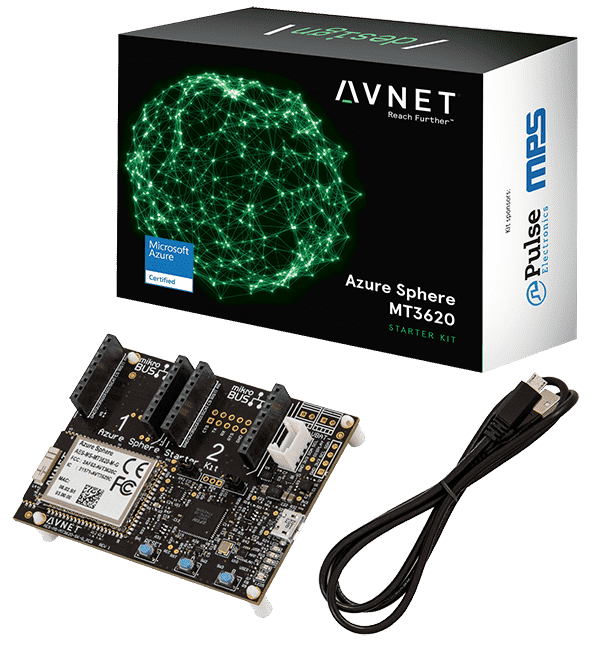To purchase this board click here

Technical Specification
The Avnet-designed, production-ready, certified Azure Sphere MT3620 module is based on the MT3620 SoC, which includes built-in Microsoft security, WiFi connectivity plus the versatility and power of an Arm Cortex
-A7 processor and two real-time Arm Cortex-M4F microcontroller cores. A suite of on-chip peripherals, real-time clock, Flash and RAM are also available. In addition to the MT3620, the 33 x 22 mm module includes a dual-band WiFi chip antenna and system clock source. Up to 27 configurable GPIOs and three configurable serial ports (UART, I2C or SPI) are accessible on the module pinout.
The carrier board connects the Sphere module I/Os to two MikroE Click sockets, an I2C Grove connector, a connector supporting the addition of an optional 128 x 64 OLED graphical display, a 3D accelerometer, 3D gyro, temperature sensor and ambient light sensor. Debugging is accomplished through a USB-to-UART interface, which also provides 5V power to the board.
User applications for the embedded Sphere controller are developed in C using Microsoft’s Visual Studio IDE and Azure Sphere SDK. Visual Studio provides a powerful yet easy-to-use development environment for compiling and debugging application code. The combination of Visual Studio, the versatile carrier card plus the production-ready Sphere module delivers a powerful starting point for IoT developers interested in learning, prototyping and deploying Azure Sphere-based solutions.
Azure Sphere Starter Kit V2 Product Brief
Click on the images to enlarge - Azure Sphere MT3620 Starter Kit V2
Carrier Board 2.0
- Azure Sphere MT3620 Module (dual-band WiFi)
- Two MikroE click board expansion sockets
- Grove expansion connector (configured as I2C)
- On-board sensors
- 3-axis accelerometer and gyro
- Ambient light sensor
- Temperature (die not ambient)
- Pressure/Barometric sensor
- Interface for optional OLED 128x64 display
- USB-based program/debug & recovery interfaces
- User push button switches and LEDs
- 5V to 3.3V power regulation
- DC supply inputs:
- USB 5V from host computer
- External 5V via terminal-block
- VBAT supply from optional coin-cell battery
Azure Sphere MT3620 Module
- MT3620AN SoC multicore device
- 1x 500MHz Arm Cortex A7, 4MB SRAM
- 2x 200MHz Arm Cortex M4F, 64KB SRAM
- 3x ISU interfaces (configured as UART, SPI, I2C)
- ADC/GPIO: 3x 12-bit ADC inputs (or 3 GPIOs)
- PWM/GPIO: 9x PWM outputs (or up to 24 GPIOs)
- RTC: Requires coin cell battery for VBAT voltage
- Wi-Fi: Dual-band 2.4/5GHz 802.11 b/g/n radio
- Antenna: Dual-band 2.4/5GHz chip antenna
Note: Azure Sphere OS support for some MT3620 features has not yet been released by Microsoft.
Target Applications
- IoT appliances and devices
- Remote access
- Smart city
- Smart agriculture
- Building automation
- Factory automation
Kit Includes
- Carrier board 2.0 with Azure Sphere MT3620 module
- USB 2.0 cable (type-A to type-B)
- Quick Start Card
Hardware Specification V1 (specifications for V2 - provided in the future)
| Specification | Description |
|---|---|
| Avnet Azure Sphere MT3620 Module |
|
| USB to Serial 4-Port Interface |
|
| On-board Sensors |
|
| Hardware Expansion Interfaces (multiple standards supported) |
|
| Push-Button Switches (3) |
|
| User and Status LEDs (7) |
|
| 5V to 3.3V DC Power Regulation (with over/under voltage protection) and Power Interfaces for |
|
| Operating Temperature |
|
| Dimensions |
|
| Certification |
|






